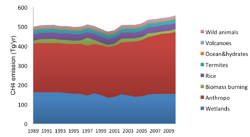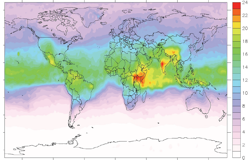Global methane modelling using FLEXPART

To improve our understanding of fundamental processes that contribute to the observed variability of atmospheric CH4 concentrations in the recent past, we use the Lagrangian transport model FLEXPART to simulate methane globally.
In the project MAIOLICA-II, the goal is to better understand methane variability and to quantify the contribution of the different emission sources, with a specific focus on wetland emissions. Our group contributes to this project (which also involves ETH, WSL, and the Centre for Climate Systems Modeling C2SM) through the global modeling of methane with the Lagrangian transport model FLEXPART, as well as inverse modeling.
We have set up FLEXPART to simulate the global atmospheric CH4 since 1990. FLEXPART is used in a domain-filling mode with about 3 million particles permanently transported forward based on wind fields from operational analyses of the European Centre for Medium-Range Weather Forecasts (ECMWF) at a high horizontal resolution of 1°x1°. FLEXPART was extended to also transport chemically active species that experience loss by reaction with OH, the primary loss reaction of CH4. CH4 tracer mass is lost further by soil uptake and stratospheric loss reactions with prescribed Cl and O(1D) radicals.

CH4 variability is analysed in terms of contributions from different source categories (Fig. 1) and different age classes. Sources are hence separated into 240 tracers, depending on source origin (anthropogenic, wetlands, rice, biomass burning, termites, wild animals, oceans, volcanoes), region of emission, and time since emission, with 5 age classes (Fig. 2).
The work is built upon the experiences made in MAIOLICA-I, and benefits from the close links to the project CarboCount-CH, which focuses on local measurements and regional modeling of CO2 and man-made CH4 emissions on the Swiss and European scale.
References:
- Bruhwiler, L. M. P., A. M. Michalak, W. Peters, D. F. Baker, and P. Tans (2005), An improved Kalman Smoother for atmospheric inversions, Atmos Chem Phys, 5, 2691- 2702.
- Henne, S., C. S. Poberaj, S. Reimann, and D. Brunner (2013), Global-Scale Tropospheric Lagrangian Particle Models With Linear Chemistry, in Lagrangian Modeling of the Atmosphere, edited, pp. 235-250, American Geophysical Union.
Contact:
-
Share

